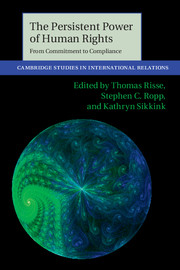Book contents
- Frontmatter
- Contents
- Figures
- Tables
- Contributors
- Preface
- Part I Introduction and stock-taking
- Part II Conceptual and methodological issues
- 4 Human rights in areas of limited statehood
- 5 The “compliance gap” and the efficacy of international human rights institutions
- 6 Social mechanisms to promote international human rights
- Part III From ratification to compliance
- Part IV From commitment to compliance
- References
- Index
6 - Social mechanisms to promote international human rights
Complementary or contradictory?
Published online by Cambridge University Press: 05 March 2013
- Frontmatter
- Contents
- Figures
- Tables
- Contributors
- Preface
- Part I Introduction and stock-taking
- Part II Conceptual and methodological issues
- 4 Human rights in areas of limited statehood
- 5 The “compliance gap” and the efficacy of international human rights institutions
- 6 Social mechanisms to promote international human rights
- Part III From ratification to compliance
- Part IV From commitment to compliance
- References
- Index
Summary
The study of the international human rights regime has increasingly emphasized how this regime matters rather than if it matters. An especially productive turn focuses on integrated conceptual models, which accept the importance of multiple forms of influence on state behavior. The Power of Human Rights (PoHR) provided a foundation for such studies by bringing attention to the significance of different logics of interaction at different points in the socialization process of states (Risse et al. 1999). That leading work and allied scholarship recognize the complexity of actor motivation, human and organizational behavior, and the global-level social environment. What is needed now is a social theory that accounts for why human rights abuses occur and how the international community does or might influence rights abusers to alter their behavior. The objective is to explain how changes in the relevant social environment – namely the existence, and ultimately the formal acceptance, of international human rights – affect the behavior of individuals, governments and non-governmental organizations.
The “spiral model” of human rights change developed in PoHR – and further elaborated in this volume – is an important step in developing such a theory. At a high level of generality, the model provides a conceptually and empirically compelling account of the relationship between national policies and formal international human rights regimes. On this model, various socialization processes work together to influence non-compliant states to accept and ultimately comply with human rights norms through a five-stage process: repression, denial, tactical concessions, prescriptive status, and rule-consistent behavior. The model emphasizes how instrumental adaptation, argumentation and habitualization impel states first to commit formally to human rights regimes and thereafter, under certain conditions, to internalize human rights norms. Four mechanisms of social influence are identified by the authors as crucial to modeling the domestic political consequences of the human rights regime: coercion; incentivization; persuasion/learning; and capacity-building.
- Type
- Chapter
- Information
- The Persistent Power of Human RightsFrom Commitment to Compliance, pp. 103 - 122Publisher: Cambridge University PressPrint publication year: 2013
- 8
- Cited by

